Vermes ("worms") is an obsolete taxon used by Carl Linnaeus and Jean-Baptiste Lamarck for non-arthropod invertebrate animals.

The rufous-tailed lark, also sometimes called the rufous-tailed finch-lark, is a ground bird found in the drier open stony habitats of India and parts of Pakistan. Like other species in the genus it has a large finch-like bill with a slightly curved edge to the upper mandible. The dull brown colour matches the soil as it forages for grass seeds, grain and insects. Males and females are indistinguishable in the field but during the breeding season, the male has a courtship display that involves flying up steeply and then nose-diving and pulling up in a series of stepped wavy dips accompanied by calling. They forage on the ground in pairs or small groups.

Hypercompe is a genus of tiger moths in the family Erebidae erected by Jacob Hübner in 1819.
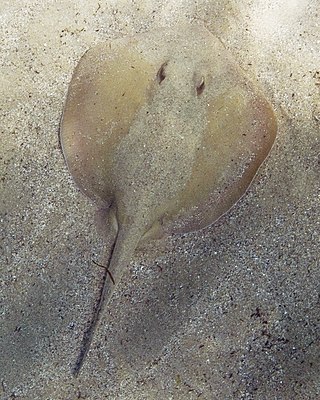
The common stingaree is a species of stingray in the family Urolophidae. The most abundant ray in inshore waters off eastern Australia, it generally inhabits estuaries, sandy flats, and rocky reefs from the shore to a depth of 60 m (200 ft). This plain brownish to grayish species has a rounded pectoral fin disc with a broadly triangular snout. Its nostrils have enlarged lobes on their outer margins and a skirt-shaped curtain of skin with a fringed posterior margin between them. Its tail bears a small dorsal fin before the stinging spine, and terminates in a leaf-shaped caudal fin. This ray can grow to 52 cm (20 in) long.

Diplodon is a genus of freshwater pearly mussel, an aquatic bivalve in the Hyriidae family.

Giuseppe Saverio Poli was an Italian physicist, biologist and natural historian.
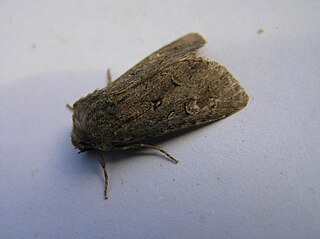
Luperina testacea, the flounced rustic, is a moth of the family Noctuidae. It is found in Europe, Asia Minor and Armenia.
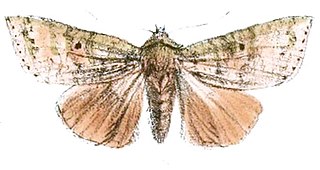
Tympanistes is a genus of moths of the family Nolidae. The genus was erected by Frederic Moore in 1867.
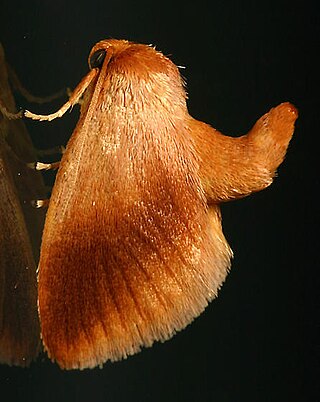
The warm-chevroned moth is a moth of the family Limacodidae. It is found from Nova Scotia west and south to Manitoba, Missouri and Mississippi. There is also a record from South Carolina.
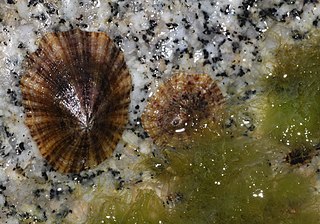
Patella caerulea, is a species of limpet in the family Patellidae. It is known by the common names Mediterranean limpet and rayed Mediterranean limpet. It is native to the Mediterranean Sea.

Agaronia testacea, a species of sea snail with the common name Panama false olive, is a marine gastropod mollusk in the family Olividae, which are known collectively as "the olives".

Angonyx testacea, the northern dark-green hawkmoth, is a moth of the family Sphingidae.

Tympanistes rubidorsalis is a species of moth of the family Nolidae. It is found in Taiwan.

Tympanistes pallida is a species of moth of the family Nolidae. It is found in India.
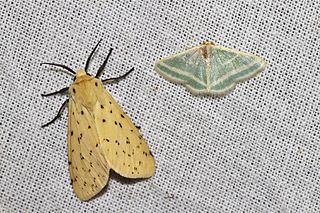
Eyralpenus testacea is a moth of the family Erebidae. It was described by Francis Walker in 1855. It is found in the Democratic Republic of the Congo and South Africa.
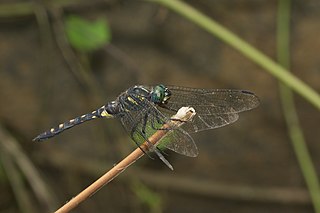
Onychothemis testacea, the stellate river hawk, or riverhawker, is a species of dragonfly in the family Libellulidae. It is widespread in many Asian countries.
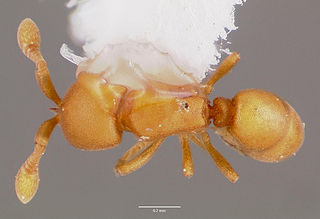
Discothyrea testacea is a species of ant in the family Formicidae.
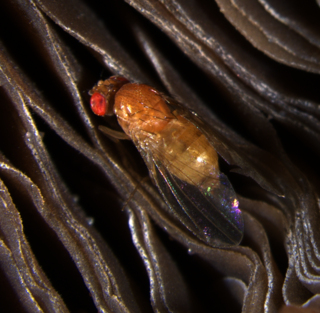
Drosophila neotestacea is a member of the testacea species group of Drosophila. Testacea species are specialist fruit flies that breed on the fruiting bodies of mushrooms. These flies will choose to breed on psychoactive mushrooms such as the Fly Agaric Amanita muscaria. Drosophila neotestacea can be found in temperate regions of North America, ranging from the north eastern United States to western Canada.

Drosophila testacea is a member of the testacea species group of Drosophila. Testacea species are specialist fruit flies that breed on the fruiting bodies of mushrooms. Drosophila testacea can be found in temperate regions of Europe, extending to East Asia. Drosophila testacea and Drosophila orientacea can produce viable hybrids, though they are separated by geography and behavioural barriers. Drosophila testacea females will also readily mate with Drosophila neotestacea males, but viable hybrids are never produced. This hybrid inviability ) may be due to selfish X chromosomes and co-evolved suppressors. Alternately, differences in sex pheromone reception could underlie female readiness and male willingness to copulate.

The Drosophila testacea species group belongs to the Immigrans-tripunctata radiation of the subgenus Drosophila, and contains 4 species: Drosophila putrida, Drosophila neotestacea, Drosophila testacea, and Drosophila orientacea. Testacea species are specialist mushroom-feeding flies, and can metabolize toxic compounds in Amanita mushrooms. The Testacea species group is studied for its specialist ecology, population genetics, and bacterial endosymbionts. The North American species Drosophila neotestacea is perhaps the best-studied of the group for its interactions with parasitic wasps and nematodes, bacterial endosymbionts, and trypanosomatid parasites. Of note, selfish X chromosomes have been discovered in three of the four Testacea group species.



















